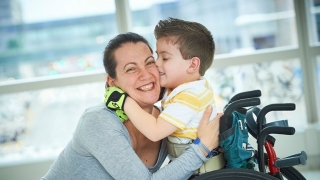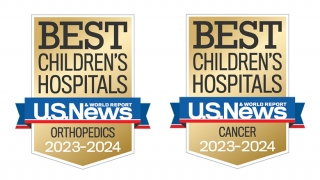Nonossifying Fibroma
What is nonossifying fibroma?
Nonossifying fibromas are the most common benign bone lesions in children. Made up mainly of fibrous (scar) tissue, nonossifying fibromas are not aggressive. They can be thought of as ‘birthmarks’ in the bone, rather than true tumors.
Nonossifying fibromas usually occur in the femur (thigh bone) or tibia (shin bone), but may also occur in the humerus (upper arm bone). These lesions occur in both boys and girls.
Experts estimate 20 percent of people younger than 20 years old have at least one nonossifying fibroma. Most will require no treatment, as the nonossifying fibroma will resolve on its own when the child is fully grown.
Nonossifying fibromas are also known as fibrous cortical defects and cortical desmoids.
Causes
The cause of nonossifying fibroma is unknown.
Signs and symptoms
Nonossifying fibromas often have no symptoms; many children do not even know they have this benign lesion until it is discovered — by chance — on an X-ray for another issue.
Those who do experience symptoms report:
- Mild swelling or soreness in the affected area.
- A dull ache in the affected area, even during periods of inactivity.
- A broken bone that is later discovered to be caused, at least partly, by the nonossifying fibroma that has weakened the overall strength of the bone. Fractures are more likely when the nonossifying fibroma is very large.
Testing and diagnosis
At Children’s Hospital of Philadelphia (CHOP), our clinical experts perform a careful and complete medical workup and examination of your child. We use a variety of diagnostic tests to diagnose nonossifying fibroma, including:
- X-rays, which produce images of bones.
- Magnetic resonance imaging (MRI), which uses a combination of large magnets, radiofrequencies and a computer to produce detailed images of organs, soft tissues, muscles, ligaments and other structures within the body. Your child is exposed to no radiation during an MRI.
- Computed tomography (CT) scan, which uses a combination of X-rays and computer technology to examine bones and produces cross-sectional images ("slices") of the body.
- EOS imaging, an imaging technology that creates 3-dimensional models from two flat images. Unlike a CT scan, EOS images are taken while the child is in an upright or standing position, enabling improved diagnosis due to weight-bearing positioning.
Treatments
Most nonossifying fibromas require no treatment. They usually resolve on their own when your child’s bones stop growing.
In some circumstances, treatment may be recommended to help stabilize the affected bone after a fracture.
There are many treatment options available for bone and soft tissue tumors, and some children will need a combination of these therapies. At CHOP, experts at the Bone and Soft Tissue Tumor Program take a team approach to treatment. Orthopaedic and other specialists collaborate to provide your child with individualized care and the best possible outcomes.
Our program is led by Kristy L. Weber, MD, and Alexandre Arkader, MD, nationally renowned surgeons who specialize in treating bone and soft tissues tumors, limb-sparing surgery and reconstructive surgery.
In rare cases that require surgical treatment, the following may be used:
- Intralesional curettage, which involves scraping out the bone to completely remove the lesion
- Bone grafting, a surgical procedure to replace missing bone with artificial graft material or cadaver bone
If your child has already sustained a broken bone, physicians may use casting or surgically placed metal rods and pins to strengthen the bone.
Your child’s clinical team will recommend the best treatment for your child’s individual situation.
Depending on the size and location of the lesion removed, your child may be able to return home that day or may spend one night in the Hospital.
Surgical safety
Though surgery for nonossifying fibroma is highly effective, we understand that any surgery can be a stressful experience for children and families. At CHOP, we offer a wealth of resources about how to prepare your child for surgery and what to expect during surgery.
Additionally, we employ numerous best practices before, during and after surgery to decrease the risk of infection and increase positive outcomes. For more details about safety protocols at Children's Hospital of Philadelphia, see safety in surgery.
Follow-up care
At Children's Hospital of Philadelphia, we offer ongoing support and services for your child and family at our Main Campus and throughout our CHOP Care Network. Our team is committed to partnering with parents and referring physicians to provide the most current, comprehensive and specialized care possible for your child.
Most patients return to full activity within 3-6 months of surgery.
The long-term outlook for children with nonossifying fibroma is excellent as they resolve when your child reaches skeletal maturity, which generally happens by age 15 for girls, and age 18 for boys.
Reviewed by Kristy L. Weber, MD, FACS, Alexandre Arkader, MD



